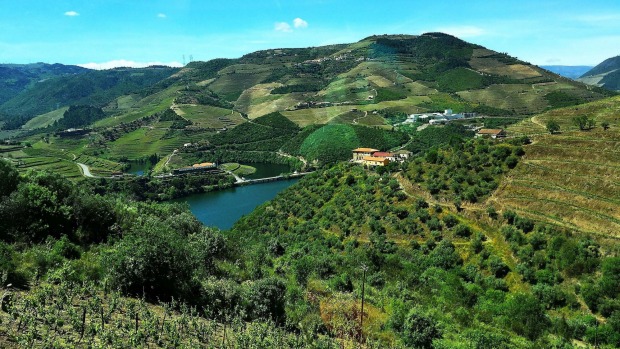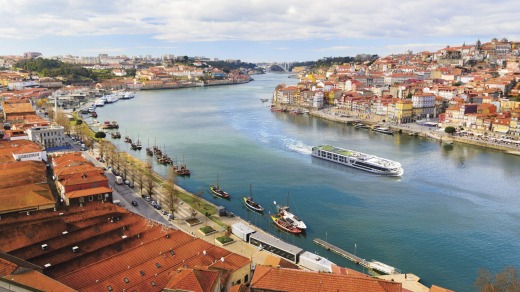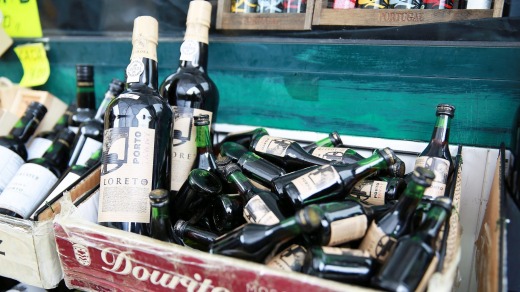
You will never see a river quite so beautiful as this, Maria Andrada says.
From our perch on the top deck of the Dom Luiz I Bridge – an arched metal sculpture connecting the Portuguese cities of Porto and Vila Nova de Gaia – we can see the Douro rolling in from the east. It crossed over from Spain into Portugal 250 kilometres away, and has flowed on for days through valleys so deep their walls loom like bulwarks beside it.
It has been accompanied all the way to Regua by terraced vineyards, their plantings defined by corrugations that curl and bend to the shape of the mountains. From within the range's folds and peaks, the quintas' manor houses have gazed down upon it. Approaching the city, the river has become choppy with the movement of the brightly-painted rabelos that sail through it and the current of this timeworn metropolis coursing through its depths.

Finally reaching the UNESCO World Heritage City of Porto, the Douro sloshes up against esplanades lined with slimline houses – terracotta-roofed, decorated with ceramic tiles, and built narrow and tall to avoid the property tax determined by the houses' footprint instead of their height. The river hasn't far to go now: it flows beneath the Maria Pia Bridge which was designed by Gustaf Eiffel, under our own feet, planted high above it on the Dom Luiz I, and out towards the river mouth where finally it is emptied into the Atlantic Ocean.
Indeed, this river – and the landscape that envelops it – is blessed with extraordinary beauty. And this coming April a new vessel will be launched upon it: Scenic's very first Portuguese river ship, the Scenic Azure. It will cruise from Porto all the way to Vega de Terron, just across the Spanish border, and back again, visiting along the way pockets of the valley often bypassed by visitors to these parts.
"We've really kept the most beautiful ports and villages on the Douro River for Scenic," Andrada says.

Though she's from Lisbon, Andrada – who is general manager for Scenic's new Portuguese operations based in Porto – knows well the treasures that are waiting to be unearthed all along this river and the valley it passes through.
My own exploration begins close to the river mouth, at the waterside municipality of Matosinhos, north-west of the city centre, where the locals come to eat. It's early evening and the disused canning factories we pass on our way there – tuna, anchovies – attest to Portugal's dwindling fish stocks. But while tuna must be sourced from Canada these days, there's an abundance of alternative seafood all along the Rua Herois de Franca: restauranteurs are setting up their grills on the esplanade and sardines and cod are sizzling above the coals.
"We love codfish," Andrada says. "And we have one-thousand ways to cook it!"
But sea bass is on the menu at Restaurante O Valentim – fresh, delicate, delicious, sourced from the Docapesca Fish Market directly across the road. It is paired with potatoes (another Portuguese staple), green beans and wine from the Douro Valley, some 100 kilometres away.
At lunch next day we cross the Douro River to the fishing village of Afurada, which sits in Vila da Nova Gaia, close to the river mouth. A woman grills sardines on the steps of her house; cats roam the streets in search of titbits; people emerge from their homes and workplaces, hungry for lunch. At Taberna Sao Pedro we sit down to platters heaving with mussels, squid, sardines, brill, potatoes and Portuguese salad.
"Don't tell us about having a sandwich," Andrada says.
"It doesn't work for us. We like to stop, we like to sit, to have a proper meal: soup, main dish, dessert and coffee. Wine, all the time. If you cannot afford wine, you will go for beer."
But the wine in this region is plentiful, too; indeed the Douro Valley is renowned for its production of port, and Porto itself is named for this sweet nectar. With the Scenic Azure receiving its finishing touches in the shipyard, we set off by road, across the Serra do Marao and onto the lip of the Douro Valley.
It is unspeakably beautiful. Olive, almond and sumac trees dominate the landscape; villages are filled with antiquated houses, walled groves of oranges and olives, and people tending their vegetable gardens. Baroque churches stand proud; the ruins of monasteries lie defeated. From up here you can see the curlicue-painted hills falling away to the river far below, and Portugal's oldest wine hotel, Quinta Nova, surveying the scene from a hilltop.
A riot of hot pink Shasta daisies welcomes us at the entrance to this establishment. It's a place that embodies the history of the Douro Valley: the hotel is located in the reconstructed, 18th century manor house, while a chapel built in 1795 references the many prayers sent out for the sailors who navigated this stretch of water, their rabelos loaded with barrels of wine.
The steep slopes on which the vines are planted induce in me a wave of vertigo. This schist-heavy soil is loosened by workhorses, and the vines – grafted onto American stock following a devastating outbreak of phylloxera in 1863 – are planted at an angle towards the sun, whose summer heat develops the high sugar content of their fruit. Mechanisation is eschewed here even when harvest time comes – to the benefit of the Douro's female population.
"We use only women to harvest the grapes," says Paula Sousa of Quinta Nova. "They're more careful and discerning than men. We are a little bit feminist like that."
But in the village of Provezende, a little further on, people still live out their lives in the most traditional of ways. It is mid-afternoon and Manuel Matos is closing Bakery Fatima for the day. His family's business is 200 years old, and his mother still bakes bread here every day. The village men sun themselves on benches out on the cobblestoned square; their wives chatter along the narrow streets that lead from it.
That night, when the sun has set over the Douro River, we gather beside a crackling fire at Morgadio da Calçada, a 17th century manor house now transformed into a boutique hotel. We raise a glass of tawny port, made from 100-year-old grapes grown right outside these windows. All of the Douro Valley is contained in its sweet, smoky palate: the tumbling hills; that roiling, quenching river; the horses grazing on patches of levelled earth; the men gossiping in the square after a day of hard work; and those women whose fingers have plucked so gently, so delicately, the fruit of the vines.
dourovalley.eu/en
Etihad Airways flies to Porto from Sydney, Melbourne, Brisbane and Perth via Abu Dhabi and Milan, codesharing with TAP Portugal. Return fares start at $1916 including taxes. See etihad.com
Scenic's 11-Day Unforgettable Douro is a round-trip journey from the World Heritage-listed city of Porto to Vega de Terron, across the Spanish border from Portugal. There is no overnight sailing, with the brand-new Scenic Azure taking in vineyards, historic towns and villages as it cruises along the Douro River. Prices start at $6775 a person, twin share. Book now to travel in 2017 at 2016 prices with included return flights to Europe; upgrade to business class from $1995 a person on selected departure dates.
A day trip to Guimaraes, north of Porto, provides the perfect introduction to early Portuguese history: this city was the seat of the first King of Portugal and is dominated by a collection of heritage buildings, including a magnificently-preserved medieval castle, the Ducal Palace, and the Sao Miguel Church, where Afonso I is rumoured to have been baptised and on whose granite walls the names of fallen knights are engraved.
On sunny days you'll find fifth-generation gardener Antonio Taveira working his magic on the beautiful grounds of this Baroque palace. Meander through a tunnel of cypresses, past a profusion of rhododendron, camellias, azaleas and magnolias, and alongside Taveira's delightful topiaries. The inside of this palace – still used as a summer house by its aristocratic owners – showcases the region's rich aristocratic history.
It was in this forested valley in the 12th century that Portugal's first king, Afonso I, was said to have been raised. The fortified Ucanha Bridge, Portugal's first toll bridge, spans the Varosa River, and a short drive away stands the Monastery of Saint John of Tarouca. The ruins of the cloisters lie beside it, a testament to the confiscation of cloisters and expulsion of religious orders from Portugal in the 19th century.
A walk through the expansive parks and gardens of Quinta Aveleda is a fairytale experience. Peacocks strut about while trees collected from around the world tower above – sequoias, palms, oaks, and a eucalypt that's more than 200 years old. Around every corner there's some folly to discover – and when the exploring is done, settle back and taste the sparkling wine for which this quinta is famous.
The history of this region is beautifully curated at this interactive, enlightening museum. Find out how the phylloxera butterfly changed the landscape of the Douro Valley; view artefacts (iron-age pottery, wine produced before the phylloxera plague, canvas and sisal baskets fastened to the heads of pickers); see how the seasons mould and shape the grapes before they are harvested; and smell the distinctive scents – cinnamon, caramel, vanilla – that are contained within this valley's port varieties.